Yinhong Liu
When Personalization Meets Reality: A Multi-Faceted Analysis of Personalized Preference Learning
Feb 26, 2025Abstract:While Reinforcement Learning from Human Feedback (RLHF) is widely used to align Large Language Models (LLMs) with human preferences, it typically assumes homogeneous preferences across users, overlooking diverse human values and minority viewpoints. Although personalized preference learning addresses this by tailoring separate preferences for individual users, the field lacks standardized methods to assess its effectiveness. We present a multi-faceted evaluation framework that measures not only performance but also fairness, unintended effects, and adaptability across varying levels of preference divergence. Through extensive experiments comparing eight personalization methods across three preference datasets, we demonstrate that performance differences between methods could reach 36% when users strongly disagree, and personalization can introduce up to 20% safety misalignment. These findings highlight the critical need for holistic evaluation approaches to advance the development of more effective and inclusive preference learning systems.
GraphCheck: Breaking Long-Term Text Barriers with Extracted Knowledge Graph-Powered Fact-Checking
Feb 23, 2025Abstract:Large language models (LLMs) are widely used, but they often generate subtle factual errors, especially in long-form text. These errors are fatal in some specialized domains such as medicine. Existing fact-checking with grounding documents methods face two main challenges: (1) they struggle to understand complex multihop relations in long documents, often overlooking subtle factual errors; (2) most specialized methods rely on pairwise comparisons, requiring multiple model calls, leading to high resource and computational costs. To address these challenges, we propose \textbf{\textit{GraphCheck}}, a fact-checking framework that uses extracted knowledge graphs to enhance text representation. Graph Neural Networks further process these graphs as a soft prompt, enabling LLMs to incorporate structured knowledge more effectively. Enhanced with graph-based reasoning, GraphCheck captures multihop reasoning chains which are often overlooked by existing methods, enabling precise and efficient fact-checking in a single inference call. Experimental results on seven benchmarks spanning both general and medical domains demonstrate a 6.1\% overall improvement over baseline models. Notably, GraphCheck outperforms existing specialized fact-checkers and achieves comparable performance with state-of-the-art LLMs, such as DeepSeek-V3 and OpenAI-o1, with significantly fewer parameters.
STAR: Spatial-Temporal Augmentation with Text-to-Video Models for Real-World Video Super-Resolution
Jan 06, 2025Abstract:Image diffusion models have been adapted for real-world video super-resolution to tackle over-smoothing issues in GAN-based methods. However, these models struggle to maintain temporal consistency, as they are trained on static images, limiting their ability to capture temporal dynamics effectively. Integrating text-to-video (T2V) models into video super-resolution for improved temporal modeling is straightforward. However, two key challenges remain: artifacts introduced by complex degradations in real-world scenarios, and compromised fidelity due to the strong generative capacity of powerful T2V models (\textit{e.g.}, CogVideoX-5B). To enhance the spatio-temporal quality of restored videos, we introduce\textbf{~\name} (\textbf{S}patial-\textbf{T}emporal \textbf{A}ugmentation with T2V models for \textbf{R}eal-world video super-resolution), a novel approach that leverages T2V models for real-world video super-resolution, achieving realistic spatial details and robust temporal consistency. Specifically, we introduce a Local Information Enhancement Module (LIEM) before the global attention block to enrich local details and mitigate degradation artifacts. Moreover, we propose a Dynamic Frequency (DF) Loss to reinforce fidelity, guiding the model to focus on different frequency components across diffusion steps. Extensive experiments demonstrate\textbf{~\name}~outperforms state-of-the-art methods on both synthetic and real-world datasets.
Prompt Compression for Large Language Models: A Survey
Oct 17, 2024Abstract:Leveraging large language models (LLMs) for complex natural language tasks typically requires long-form prompts to convey detailed requirements and information, which results in increased memory usage and inference costs. To mitigate these challenges, multiple efficient methods have been proposed, with prompt compression gaining significant research interest. This survey provides an overview of prompt compression techniques, categorized into hard prompt methods and soft prompt methods. First, the technical approaches of these methods are compared, followed by an exploration of various ways to understand their mechanisms, including the perspectives of attention optimization, Parameter-Efficient Fine-Tuning (PEFT), modality integration, and new synthetic language. We also examine the downstream adaptations of various prompt compression techniques. Finally, the limitations of current prompt compression methods are analyzed, and several future directions are outlined, such as optimizing the compression encoder, combining hard and soft prompts methods, and leveraging insights from multimodality.
Aligning with Logic: Measuring, Evaluating and Improving Logical Consistency in Large Language Models
Oct 05, 2024



Abstract:Recent research in Large Language Models (LLMs) has shown promising progress related to LLM alignment with human preferences. LLM-empowered decision-making systems are expected to be predictable, reliable and trustworthy, which implies being free from paradoxes or contradictions that could undermine their credibility and validity. However, LLMs still exhibit inconsistent and biased behaviour when making decisions or judgements. In this work, we focus on studying logical consistency of LLMs as a prerequisite for more reliable and trustworthy systems. Logical consistency ensures that decisions are based on a stable and coherent understanding of the problem, reducing the risk of erratic or contradictory outputs. We first propose a universal framework to quantify the logical consistency via three fundamental proxies: transitivity, commutativity and negation invariance. We then evaluate logical consistency, using the defined measures, of a wide range of LLMs, demonstrating that it can serve as a strong proxy for overall robustness. Additionally, we introduce a data refinement and augmentation technique that enhances the logical consistency of LLMs without sacrificing alignment to human preferences. It augments noisy and sparse pairwise-comparison annotations by estimating a partially or totally ordered preference rankings using rank aggregation methods. Finally, we show that logical consistency impacts the performance of LLM-based logic-dependent algorithms, where LLMs serve as logical operators.
Measuring, Evaluating and Improving Logical Consistency in Large Language Models
Oct 03, 2024



Abstract:Recent research in Large Language Models (LLMs) has shown promising progress related to LLM alignment with human preferences. LLM-empowered decision-making systems are expected to be predictable, reliable and trustworthy, which implies being free from paradoxes or contradictions that could undermine their credibility and validity. However, LLMs still exhibit inconsistent and biased behaviour when making decisions or judgements. In this work, we focus on studying logical consistency of LLMs as a prerequisite for more reliable and trustworthy systems. Logical consistency ensures that decisions are based on a stable and coherent understanding of the problem, reducing the risk of erratic or contradictory outputs. We first propose a universal framework to quantify the logical consistency via three fundamental proxies: transitivity, commutativity and negation invariance. We then evaluate logical consistency, using the defined measures, of a wide range of LLMs, demonstrating that it can serve as a strong proxy for overall robustness. Additionally, we introduce a data refinement and augmentation technique that enhances the logical consistency of LLMs without sacrificing alignment to human preferences. It augments noisy and sparse pairwise-comparison annotations by estimating a partially or totally ordered preference rankings using rank aggregation methods. Finally, we show that logical consistency impacts the performance of LLM-based logic-dependent algorithms, where LLMs serve as logical operators.
Full-Duplex ISAC-Enabled D2D Underlaid Cellular Networks: Joint Transceiver Beamforming and Power Allocation
Aug 22, 2024



Abstract:Integrating device-to-device (D2D) communication into cellular networks can significantly reduce the transmission burden on base stations (BSs). Besides, integrated sensing and communication (ISAC) is envisioned as a key feature in future wireless networks. In this work, we consider a full-duplex ISAC- based D2D underlaid system, and propose a joint beamforming and power allocation scheme to improve the performance of the coexisting ISAC and D2D networks. To enhance spectral efficiency, a sum rate maximization problem is formulated for the full-duplex ISAC-based D2D underlaid system, which is non-convex. To solve the non-convex optimization problem, we propose a successive convex approximation (SCA)-based iterative algorithm and prove its convergence. Numerical results are provided to validate the effectiveness of the proposed scheme with the iterative algorithm, demonstrating that the proposed scheme outperforms state-of-the-art ones in both communication and sensing performance.
MR-BEN: A Comprehensive Meta-Reasoning Benchmark for Large Language Models
Jun 20, 2024
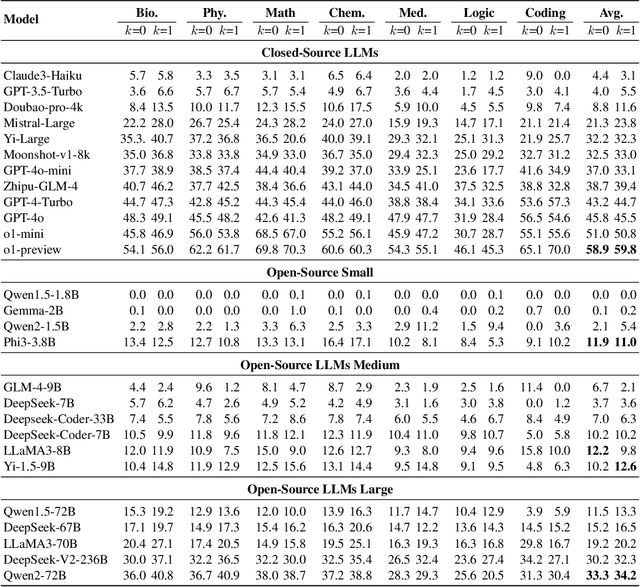
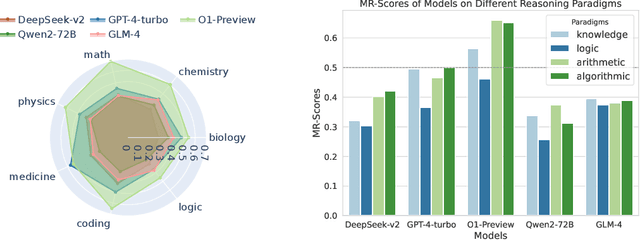

Abstract:Large language models (LLMs) have shown increasing capability in problem-solving and decision-making, largely based on the step-by-step chain-of-thought reasoning processes. However, it has been increasingly challenging to evaluate the reasoning capability of LLMs. Concretely, existing outcome-based benchmarks begin to saturate and become less sufficient to monitor the progress. To this end, we present a process-based benchmark MR-BEN that demands a meta reasoning skill, where LMs are asked to locate and analyse potential errors in automatically generated reasoning steps. MR-BEN is a comprehensive benchmark comprising 5,975 questions collected from human experts, covering various subjects such as physics, chemistry, logic, coding, and more. Through our designed metrics for assessing meta-reasoning on this benchmark, we identify interesting limitations and weaknesses of current LLMs (open-source and closed-source models). For example, open-source models are seemingly comparable to GPT-4 on outcome-based benchmarks, but they lag far behind on our benchmark, revealing the underlying reasoning capability gap between them. Our dataset and codes are available on https://randolph-zeng.github.io/Mr-Ben.github.io/.
Fairer Preferences Elicit Improved Human-Aligned Large Language Model Judgments
Jun 17, 2024Abstract:Large language models (LLMs) have shown promising abilities as cost-effective and reference-free evaluators for assessing language generation quality. In particular, pairwise LLM evaluators, which compare two generated texts and determine the preferred one, have been employed in a wide range of applications. However, LLMs exhibit preference biases and worrying sensitivity to prompt designs. In this work, we first reveal that the predictive preference of LLMs can be highly brittle and skewed, even with semantically equivalent instructions. We find that fairer predictive preferences from LLMs consistently lead to judgments that are better aligned with humans. Motivated by this phenomenon, we propose an automatic Zero-shot Evaluation-oriented Prompt Optimization framework, ZEPO, which aims to produce fairer preference decisions and improve the alignment of LLM evaluators with human judgments. To this end, we propose a zero-shot learning objective based on the preference decision fairness. ZEPO demonstrates substantial performance improvements over state-of-the-art LLM evaluators, without requiring labeled data, on representative meta-evaluation benchmarks. Our findings underscore the critical correlation between preference fairness and human alignment, positioning ZEPO as an efficient prompt optimizer for bridging the gap between LLM evaluators and human judgments.
A Multi-module Robust Method for Transient Stability Assessment against False Label Injection Cyberattacks
Jun 10, 2024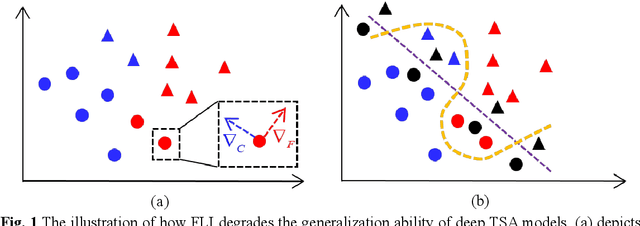
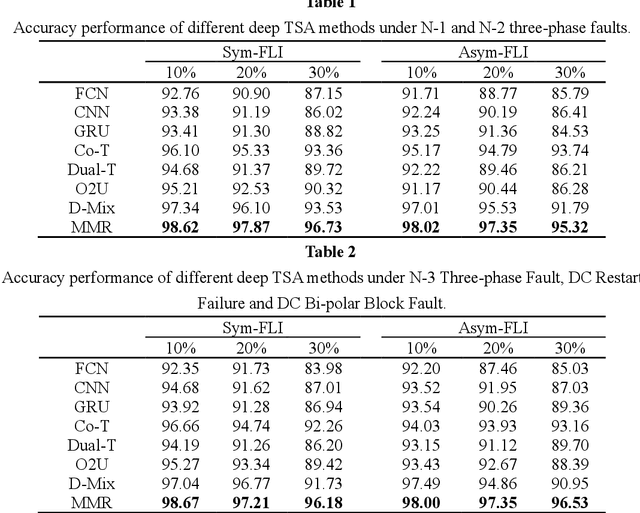
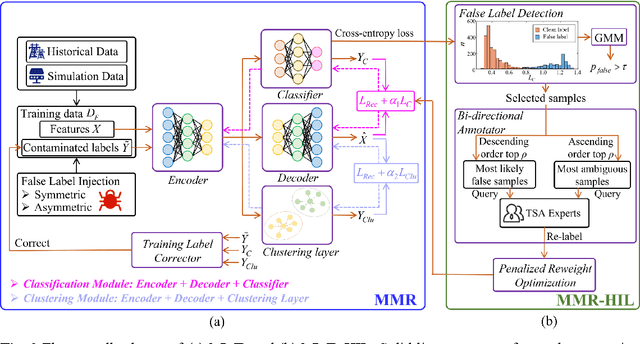
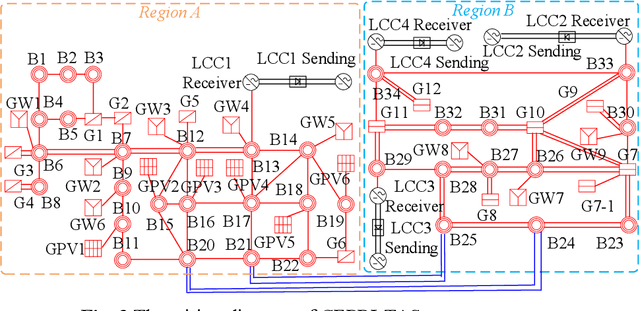
Abstract:The success of deep learning in transient stability assessment (TSA) heavily relies on high-quality training data. However, the label information in TSA datasets is vulnerable to contamination through false label injection (FLI) cyberattacks, resulting in degraded performance of deep TSA models. To address this challenge, a Multi-Module Robust TSA method (MMR) is proposed to rectify the supervised training process misguided by FLI in an unsupervised manner. In MMR, a supervised classification module and an unsupervised clustering module are alternatively trained to improve the clustering friendliness of representation leaning, thereby achieving accurate clustering assignments. Leveraging the clustering assignments, we construct a training label corrector to rectify the injected false labels and progressively enhance robustness and resilience against FLI. However, there is still a gap on accuracy and convergence speed between MMR and FLI-free deep TSA models. To narrow this gap, we further propose a human-in-the-loop training strategy, named MMR-HIL. In MMR-HIL, potential false samples can be detected by modeling the training loss with a Gaussian distribution. From these samples, the most likely false samples and most ambiguous samples are re-labeled by a TSA experts guided bi-directional annotator and then subjected to penalized optimization, aimed at improving accuracy and convergence speed. Extensive experiments indicate that MMR and MMR-HIL both exhibit powerful robustness against FLI in TSA performance. Moreover, the contaminated labels can also be effectively corrected, demonstrating superior resilience of the proposed methods.
 Add to Chrome
Add to Chrome Add to Firefox
Add to Firefox Add to Edge
Add to Edge